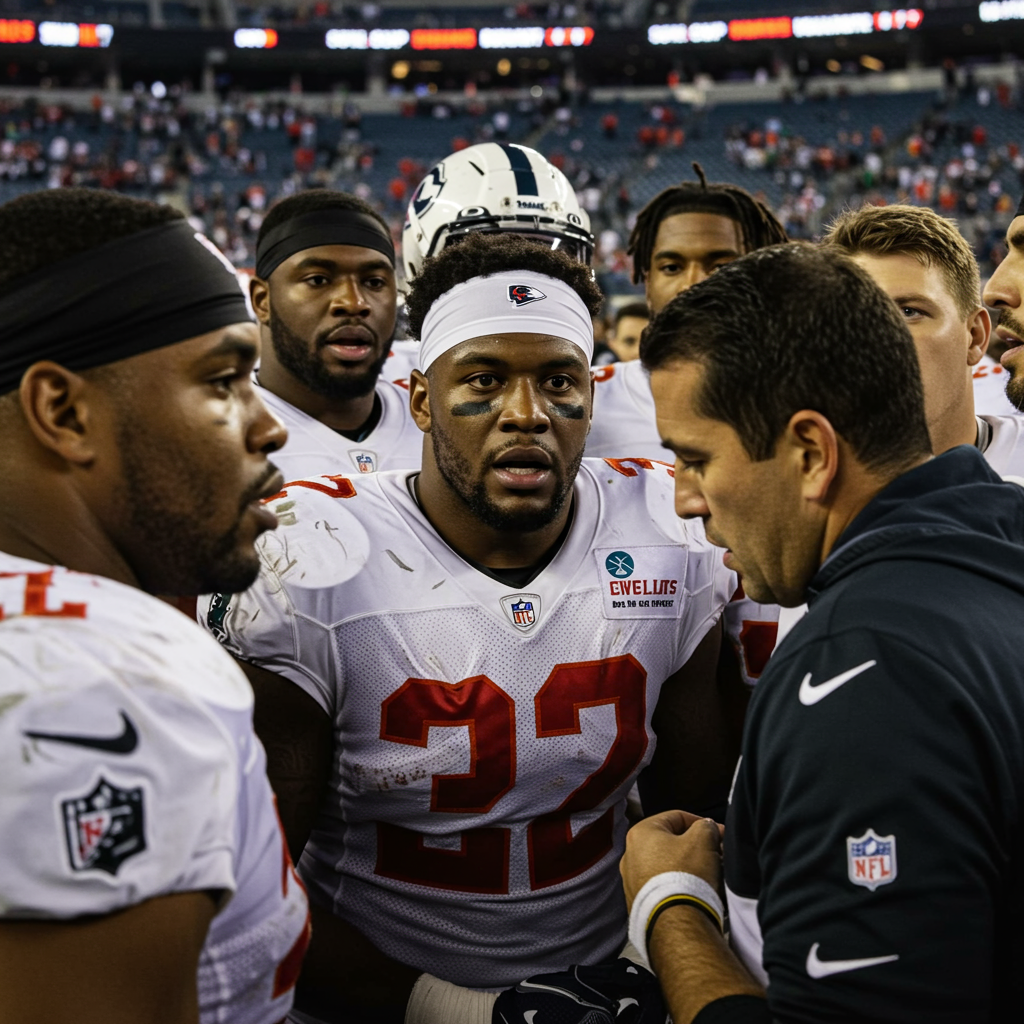The NFL offseason culminates in one of its most intense and emotionally charged periods: final roster cuts. For hundreds of players across the league, these critical few days mark the precipice of their professional dreams, a stark intersection of athletic ambition and cold, hard business. As teams finalize their 53-man rosters, players confront an undeniable reality, learning to navigate profound uncertainty with resilience and strategic foresight.
The Crucial Deadline: Unpacking NFL Roster Cuts
Every year, by Tuesday at 4 p.m. EST, all 32 NFL clubs must trim their expansive training camp rosters down to the initial 53-man squad. What begins with around 90 hopefuls per team—sometimes more, accounting for International Pathway Players—dramatically shrinks. This process means a staggering number of athletes, roughly 37 per team or 1,184 league-wide, receive the news that their current NFL journey is paused or, in some cases, ended.
The Numbers Game and Beyond
These numbers, however, don’t always tell the full story. Not every player released is at the absolute end of their path. Some individuals might transition to different classifications, keeping them in the team’s orbit without occupying a precious 53-man roster spot. This includes players on the Physically Unable to Perform (PUP) list or the Non-Football Injury/Illness (NFI) list. For instance, the Panthers began their 2025 training camp with tight end Tommy Tremble (recovering from back surgery) and wide receiver Dan Chisena (a special teams veteran) on the active/PUP list, and punter Sam Martin on the active/NFI list. These players can return to practice once cleared, illustrating that these lists offer a temporary holding pattern, not a final cut.
The day after the initial 53-man roster is set, teams swiftly begin assembling their 16-man practice squads (or 17 if an IPP player is retained). These squads are crucial, providing a pipeline for potential in-season call-ups due to injuries or performance needs. While these opportunities exist, they are significantly fewer than the sheer volume of players facing cuts. Behind every number and every classification, a player’s dreams hang in the balance.
Player Perspectives: Navigating the Emotional Gauntlet
The weight of roster cut day is palpable. Players openly acknowledge the immense stress that permeates the locker room during this period. “It can—this time can be stressful for a lot of guys,” admits Panthers tight end James Mitchell, acknowledging his own vulnerability to the pressure.
Veteran Wisdom and Rookie Readiness
For seasoned veterans like linebacker Jon Rhattigan, who has experienced the rollercoaster of being waived, signed to practice squads, and elevated multiple times with the Seahawks, there’s a certain stoicism. “I think you get to a certain point in your career where you just understand that it is what it is,” Rhattigan explains. His coping strategy revolves around “controlling the controllables,” a philosophy shared by many in the league. He understands that the NFL is a business where many decisions are “out of our control.”
Rookies, like running back Trevor Etienne, lean heavily on this veteran advice. “It’s like you really can’t control that, so just worry about the things you can control and… be ready when your name is called,” Etienne echoes. This focus on readiness and seizing opportunities is a recurring theme among players trying to solidify their place. This “controlling the controllables” also extends to player conduct on the field. Even established players understand the need for discipline. Take the incident with wide receiver Xavier Legette’s ejection from a preseason game for throwing punches: while not a roster cut, it highlights how coaches emphasize self-control and smart play as critical aspects of a player’s professional evaluation.
Coping Strategies: Leaning on Support & Inner Strength
When careers hang in the balance, players employ various strategies to manage the immense psychological toll. The uncertainty is a heavy burden, but resilience shines through.
External Support and Internal Focus
James Mitchell, for instance, finds solace in his closest relationships. “Just try to connect with family and friends, you know, that’s how I kind of just take my mind off of it,” he shared. Surrounding himself with those who have supported his journey provides a vital emotional anchor. His own career path includes making the 53-man roster for two years with the Lions, then facing a cut and practice squad signing before a mid-season elevation—experiences that underscore the unpredictable nature of an NFL career.
Jon Rhattigan’s approach emphasizes the internal. He understands that while he hopes to continue with his current teammates, adaptability is key. “You always have to be ready for any move to be made… crazy things can happen,” he notes. The mantra of controlling only what’s within one’s power provides a grounding perspective in a chaotic environment.
Coaching Philosophy: Dave Canales’ Message of Hope & Perseverance
Panthers Head Coach Dave Canales acknowledges the inherent difficulty of roster cut week. However, his focus, and that of his staff, remains on maximizing every player’s opportunity until the very last moment. Following the final preseason game, the emphasis is on film evaluation and coaching for improvement.
The “Football Life” Mandate
Canales passionately preaches a message of perseverance to all players, especially those facing release. “It’s just the challenge to chase your dream; the challenge to never give up, never say never, and to continue to work,” he shares. The coaching staff’s ultimate goal extends beyond their immediate roster, aiming to help every player find a “football life in one way, shape or form,” ensuring they feel supported and well-coached throughout their time with the team.
The Bryce Perkins Blueprint: A Testament to Resilience
A powerful embodiment of this message is quarterback Bryce Perkins. After an MVP season in the United Football League (UFL) with the Michigan Panthers, Perkins made a swift return to the NFL, signing with the Carolina Panthers amidst their own quarterback availability issues in August 2025. This wasn’t just a signing; it was a testament to his unwavering dedication.
Perkins’ journey showcases that an NFL “no” doesn’t have to be the end. After spending three seasons with the Los Angeles Rams, where he gained invaluable experience in Sean McVay’s complex offensive system, he embraced the UFL. There, despite missing three games due to injury, he led his team to the championship, completing nearly 70% of his passes for 1,918 yards and 14 touchdowns, while also rushing for 310 yards and six scores. This stellar performance caught the Panthers’ eye.
Upon his return, Perkins noted the “similar stuff, carryovers, just different names” in the Panthers’ offensive scheme, a benefit of his prior NFL experience. He described this opportunity as a crucial “audition,” highlighting his continuous work on post-snap reads, field vision, throwing accuracy, and pocket presence. Canales expressed excitement, seeing Perkins as a reward for excelling in another league. Perkins’ story powerfully illustrates Canales’ belief: when the NFL says no, finding another place to play and prove oneself keeps the dream alive.
The Human Element: Dreams, Business, and the Path Forward
Ultimately, NFL roster cuts represent a complex tapestry woven from individual dreams, team strategy, and the inherent business nature of professional sports. It’s a period of intense pressure, where split-second decisions by management impact careers that are years in the making. While the numbers can seem overwhelming, it’s crucial to remember the human stories behind each choice. Players demonstrate incredible mental fortitude, leaning on proven coping mechanisms and the wisdom of those who have navigated similar paths. For many, it’s not an end, but a pivotal moment that redefines their journey, pushing them to chase opportunities with renewed passion and an unyielding commitment to the game they love.
Frequently Asked Questions
What exactly happens during the NFL roster cut period?
The NFL roster cut period is an annual event where teams reduce their training camp rosters, typically around 90 players, to the final 53-man active roster. This must be completed by Tuesday at 4 p.m. EST. This process results in approximately 37 players per team, or 1,184 players league-wide, being released or waived. However, not all removed players are completely out of the system; some may be placed on reserve lists like PUP (Physically Unable to Perform) or NFI (Non-Football Injury), or signed to a 16- or 17-man practice squad formed the day after the initial cuts.
How do players emotionally cope with the uncertainty of roster cuts?
Players often describe the roster cut period as highly stressful. Many, particularly veterans like Jon Rhattigan, adopt a philosophy of “controlling the controllables,” acknowledging that many decisions are out of their hands. They focus on their performance, preparedness, and attitude. Others, like James Mitchell, rely on external support, connecting with family and friends to take their minds off the uncertainty. Rookies are advised to embrace readiness for any opportunity, understanding that the league is a business where sudden changes are common.
What alternative opportunities exist for players not making the 53-man roster?
Players who don’t make the initial 53-man roster have several paths forward. The most immediate is being signed to a team’s practice squad, which can lead to in-season elevations to the active roster due to injuries. Beyond a specific team, players can be picked up by other NFL teams or explore opportunities in other professional leagues, such as the United Football League (UFL). The example of Bryce Perkins, who excelled in the UFL and earned an NFL return, highlights that perseverance and continued play in other leagues can lead to future NFL auditions and a sustained “football life.”




